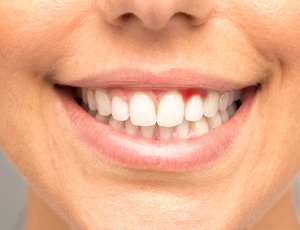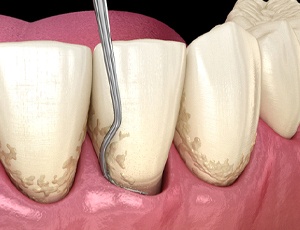Scaling & Root Planing – Carrollton, TX
Keeping Your Smile Safe from Gum Disease
Gum disease can be considered an even bigger threat to your oral health than cavities. Not only is it the leading cause of tooth loss, but it also affects half of all adults in the United States in one form or another. It’s best to have gum disease treated before any permanent damage is done, which is where scaling and root planing come in. These two procedures are collectively known as a deep cleaning, and they can help stop gum disease from advancing any further. Call our practice today to set up a periodontal appointment with Dr. Azmoodeh to see if your smile could benefit from scaling and root planing.
Do I Need Scaling and Root Planing?

Scaling and root planing may be necessary when large amounts of plaque and tartar have formed between the teeth and between the gumline. If plaque and tartar aren’t removed during regular cleanings, they can lead to gingivitis, the earliest stage of gum disease. Gingivitis initially manifests in the form of red or swollen gums, and it may cause light bleeding whenever you brush or floss. As time passes, the infection in your gums can spread, and gingivitis will eventually turn into periodontitis. If left untreated, periodontitis can cause tooth loss and may even contribute to a variety of health problems such as heart disease and diabetes. In order to avoid the worst effects of gum disease, Dr. Azmoodeh can remove plaque and tartar from your teeth and gums with scaling and root planing.
What Can I Expect During the Scaling and Root Planing Procedure?

Scaling is the first step in the deep cleaning procedure. We take a special dental instrument and use it to get rid of plaque and tartar above the gum line as well as deep in the periodontal pockets (the spaces between the teeth and gums that form as a result of gum infection). Getting rid of oral bacteria wherever it’s hiding in your mouth is crucial for preventing further damage.
Next, root planing is performed. A different dental instrument is used to smooth out the roots of your teeth. The purpose of this is twofold. First, it ensures that there are fewer rough surfaces on your teeth, which means it will be more difficult for bacteria to accumulate in these areas in the future. Second, it encourages the gum tissue to reattach to your teeth, thus speeding up the healing process. Note that scaling and root planing may need to be performed over the course of several appointments depending on the severity of your gum disease.
How Can I Take Care of My Smile Afterwards?

After scaling and root planing are complete, you may experience some minor soreness in your mouth, your teeth might be somewhat sensitive, and your gums might bleed slightly. During your recovery, you should focus on staying comfortable while protecting yourself from infection. We can give you aftercare instructions after your procedure, and we may prescribe special mouth rinse or an antibiotic if needed. In general, though, you can relieve your pain with over-the-counter medications such as ibuprofen. It should take about a week or two for your gums to fully heal.
